Bahawalpur – The Christian Community
May 7, 2006
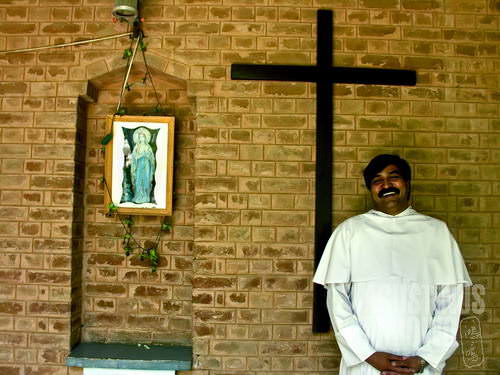
Father Nadeem Joseph
That morning, 28 October 2001, just few minutes before 9, the Christian Protestant devotees were just finishing their weekly mass. The church was a Catholic curch, St Dominic Church, in the Model Town area, a well-to-do area in Bahawalpur. The Protestant were allowed to do mass here, with the concession with the Catholic fathers. They were given the morning shift, from 8 to 9. The mass has just almost finished, the pastor walked toward the gate, and the people following him, ready to receive blessing.
Suddenly two strangers with machine guns came through the door, splashing the bullets from their weapons to all directions. The hungry bullets flew to the breasts, legs, chests, women, children, men, everybody. The casualties was not few, 16 people killed by the firing.
This was the first in Pakistan history of brutality against Christian minority. But it was not the last.
The church is a small building, very simply decorated, with only three rows of benches in both male and female quarters. Most of the spaces given to visitors were matrass. The devotees sat on their knee while delivering their prayers here. In Urdu, church is “girjah”, sounds quite similar to Indonesian word, “gereja”. While the Indonesian word used Portuguese origin “igreja”, the Urdu ones have its own meaning. “Gir” in Urdu means to fall down, and “jah” means place. Girjah means the place to bow, in front of God. And the meaning was emphasized by the absence of benches.
“Are you Christian?” asked a police to me when I tried to attend the mass today.
The security protection on the churches was much heavier now, as churches had been targets for terrorist attacks. The policemen asked about everything inside of my bag and pockets to assure that I didnt bring anything harmful.
The weekly Sunday mass for the Chatolics of the area started at 8:45. Shoes and sandals were to be put outside the building. The women went to the left side, and men on the right. When the mass started there were only groups of boys and girls. The girls wore school uniform of blue kameez and white shalwar, combined with white dupata – common uniforms for primary school students. There were some women and men already, sitting on the matrass. More and more people coming during the mass. Being late is not a big matter.
The male devotees mostly wore the salwar kameez, Pakistani national dress. Some young boys were wearing ‘pantshirt’ – modern dress of shirt combined with jeans. All women were wearing salwar kameez, colourful Pakistani dress, combined with dupata which resembled a hejab to cover the hair. Previously I thought that salwar kameez is only dominated by the Muslims, as in India the clothes do signify the religions: Muslims with salwar kameez, and Hindus with sarees. But in Pakistan it was not the case. Some elder women and men were sitting on the back benches. Bowing on matrass might be difficult for them. There were three western women wearing white salwar kameez along with hejab sitting on the bench in female part.
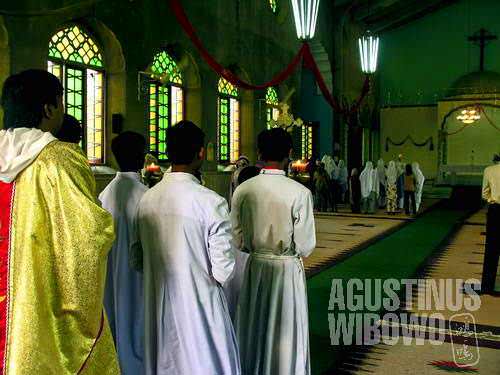
The mass begins
The mass was completely delivered in Urdu, by Father Nadeem Joseph, the headmaster of St Dominic Convent School. I barely understood anything, except the Prayer of Our Father (Doa Bapa Kami). The mass included several times of sitting and standing, and sometimes bending on knees for the prayers, also the Holy Bread and Wine, and donation session. Children were more than happy to distribute the donation basket along the sitting devotees. The slow and melancholic songs, typical of Catholic, was played with local instruments of harmonion organ and rebana, the same instruments as those used in Sufi qawwali music. The word they used to address God in Urdu is “Khuda”, shared by both of Muslims and Christians. The position of “Khuda” might be comparable with the Indonesian term of “Tuhan”.
Father Nadeem, despite of his business, allowed for me some time to learn about the history of this church. After the mass he still had to do a bapticism, and then he asked me to meet him in the Palace. But when we met, Father was busy with some workers, giving instructions of the building of the new school laboratory and computer room.
The principal room was a nice little room, with several pictures on the wall: Quad-i-Azam (Ali Jinnah, the founder of Pakistan), Jesus, and some other holy men. The ceiling fan cooled down the temperature of Pakistan summer.
St Dominic Convent School was founded in 1957 by American Dominican Missionary, with their mission on religiousity, education, medication, and financial assistance. The missionary not only built the school, but also along with church, dispensary, and hospital. In fact in the area there is still the Medical School, now government owned.
The whole area was actually once government owned. In 1969 President Zulfiqar Ali Bhutto took over amost all of the missionary built schools across Pakistan. He excused that Pakistan still need more infrastructure, so that in order to enforce education, these private schools have to be government-owned. It was just recently that the school was returned back to the Church.
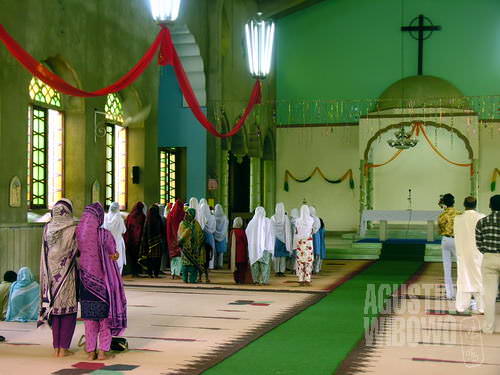
Christian church in Bahawalpur
It happened in 2001. The school building was returned almost empty. The goverment teachers had stolen everything: tables, chairs, laboratory equipments, anything. It was either stolen or damaged or burnt down. And for this empty damaged school building, instead the Church might receive 30 years of rental fee from the Government, the Church had to pay 10 lakh Rs (1 million Rs) to get it back. The government said it was to pay the fees of the teachers.
St Dominic Convent School was the first missionary school to returned back to its original foundation, under the rule of President General Pervez Musharraf. But this fate only would happen to schools which were originally founded by foreign missionaries, not the local ones.
Father Nadeem sighed that the 30 years under the government rule was indeed a huge drop drawback to the Christian community in that area. And now they had to start again from the beginning. The tuition fee was 250 Rs per month per student, for their 450+ students. But the fee was also negotiable, according to one’s economic situation. The boys are separated from the girls, but the female teachers also did teach the male students, and vice versa.
In the same year, American attack towards Afghanistan with support of Pakistan government had raged the people of Pakistan. The Muslim brotherhood slogans were strong everywhere in the world, and Pakistan was among the most rocked countries.
It was also the Muslim Brotherhood, said Father Nadeem, which brought the tragedy to this church, with 16 victims of casualties, and undescripable fear among the Christian minorities. There were 8 people involved into the attack of St Dominic Church: 2 with machine guns coming inside the Church, 2 outside, 2 on the corner of the yard, 1 in the garden, and another one on the other corner. The attackers were trialed. Their original aim was not the Protestants, actually, but the Chatolics, as there were more than 300 people gathering on every mass. Three hundred was much a bigger harvest. But the attackers missed the information that the shift between Protestants and Chatolics using the same church was just exchanged a week before, the Protestants had the morning 8 pm – 9 pm shift, and the Chatolics at 9 until 10.
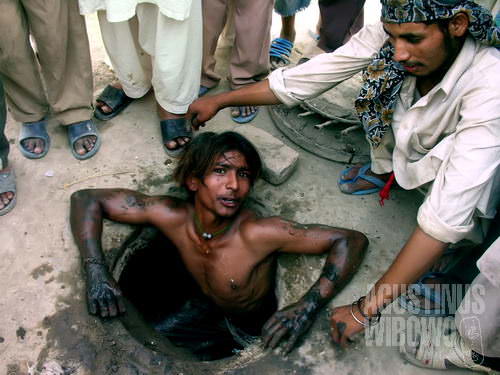
For the religious minorities, seeking job in Pakistan is a huge problem
The people were so angry when Bush attacked their Muslim brothers in Afghanistan, and to teach Bush, then they kill his “Christian brothers” here in Pakistan.
“We also dont like Bush, but why they attacked us?” asked Father rethorically.
He also doubted that Bush would even notice this “teaching” directed to him. But the 16 casualties wont come back, and the sorrow upon Christian minorities in Pakistan were getting heavier.
“Because of Bush attack, now Christian life is under sorrow in Pakistan,” explained Nadeem, “in 2001 up till now, there were many other churces were attacked for the same reason”. Actually at almost the same time, in Indonesia attacks towards churches were also very popular, mostly due to Muslim-Christian war in Maluku and world situation against the Muslim world. But Father Nadeem meant that the sorrow started long before the 2001, and is still heavy up till now.
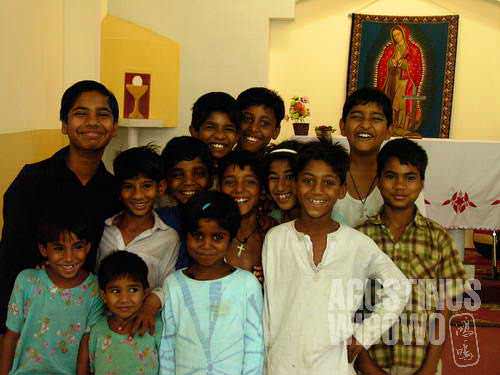
Churches are deserted. They are still afraid to go to church.
“Christians are regarded as foreigners in Pakistan,” said him, “there are too many discriminatory laws against us.” The passport and ID Card contain information of the religion of the bearer. All students in Pakistan had to study Islamiyat (Islam knowledge) no matter what their religion is. In missionary school like this, the Muslim students studied the Islamiyat and the Christians studied the Christianity. But this freedom was only given five to six years back, and only limited to education up till matrix. Further than that, all students have to learn Islamiyat. No matter how, you couldnt avoid Islamiyat subject in this country.
“We dont feel freedom in Pakistan. If the government dont give us protection, then how we feel secured, how could we feel save?”
He didnt need the answer.
Pakistan was not an Awami Republic when founded, and changed to be Islamic Republic 9 years after independence. President Zulfiqar Ali Bhutto was secular, compared to his successor who grabbed him down through a coup d’etat, President Zia-ul-Haq. Under Zia there were more discriminatory laws against the minorities (Christian, Hindus, and others) to gain more support from the Muslim clergys (mullahs). Mullahism was on its peak in this country by that time.
At this moment the proportion of Christians in Pakistan community was merely about 2.5 %. In Bahawalpur only there were twenty to twenty-five thousands believers (1200 families), served by the three Chatolic church and one Protestant church. The Protestants decided to make their own church after the attack. The Chatolics used the upper chapel as their temporary church for quite a while, until the fear relaxed down.
“We are not (regarded as) Pakistanis. We are just Christians,” sighed the Father.
***
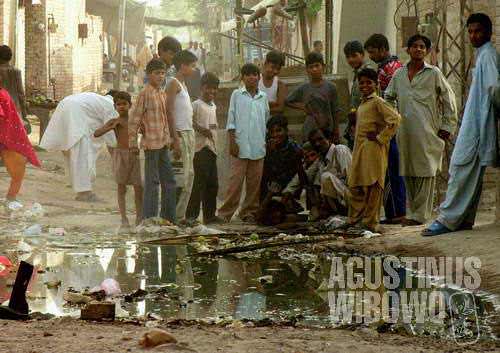
The poor neighborhood inhabited by the Christians
His name is Pervez Masih, 34 years old, a Christian believer living in slum Bhatta Number 2, just opposite of Sadiq Public School, the most famous school in Panjab raised by the Abbassi family and restricted to the upper class only. The slum just a few second of walking distance from this untouchable area. Almost all people in this complex were Catholic Christians. Pervez said there should be at least 450 families here. Considering the number of Christians and comparing to the number of devotees going to the Sunday Mass in the biggest church which was not more than 150 people, it seemed that most people didnt perform mass. Pervez said that it was due to the firing tragedy in 2001, up till now the people were still afraid.
Pervez invited me to his simple house. The alleys in the area, sprawled linearly each other, was much less of hygienic standard compared to other neighbourhoods in this town. There was dirty water flooding the pathway, seemed that the water line was blocked and people in neighbourhood worked together to clean up the waterway. Pervez was working as a caretaker (chowkidar) in St Dominic Convent School when the firing happened, and he quited his job immediately after the mass killing. He said that he didnt have work at all at this moment, but it was open secret that almost every family in this complex was involved in alcohol making and trading business.
He was little bit reluctant of photography, but not were the children. Pervez took me to the local graveyard, with several very old tombs dated more than 200 years ago, apparently of the European missionary who brought Christianity here. When Christianity reached this area of Bahawalpur? Two hundreds years ago the whole area was just jungle, and almost no people at all. Rauf, whose name -as any other majority Christians here- is also Islamic name, estimated that forty to fifty years ago the whole area was converted to Christianity.
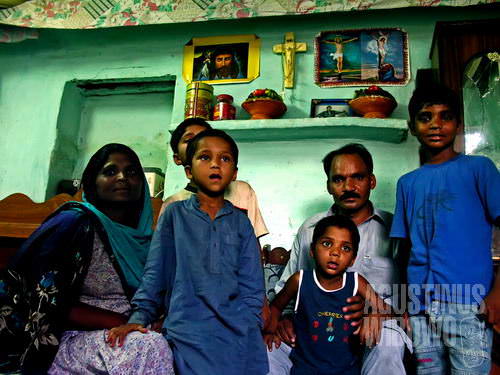
A Chritian family
There was a small church in the neighbourhood, Infant Jesus Church. It was locked. The men tried hard to find the caretaker to get the key and show the church to me. It was a small church, simple but lovely, with no benches at all. In Pakistan it’s customary for the Christians to bend on kness when delivering prayers in churches. There was a big picture of Madonna (Maryam) on altar, and two tabernacles.
In this area, Christians were mostly poor, compared to the majority Muslims. Most of them worked as government servant (sarkari mulazam), but never held spokeable seat. The work as government servant is mostly limited to sweepers in government offices. Some with non-governmental work: sweepers in houses of rich people. The hidden business here is wine making, about a hundred rupees for a small packet. The neighbourhood is underdeveloped. The families were relatively big, the family planning programme even had not touced the Christian community yet.

Most of them are poor
Why the Christians were poorer and suffered in life? Adin, my Muslim friend, said that it was because of their drinking habit that made them lazy. It was a contrast with the fact and belief that education in Christian schools were said to be among the best.
This area was famous since the sabotation on the plane of President Zia ul Haq, crushed into a river nearby. Since then many foreigners visiting Bahawalpur, and the people in this Christian slum were not surprised by the existence of foreigners.
“Come…, take a drink,” Pervez offered me alcohol.
I thankfully refused him.






Leave a comment